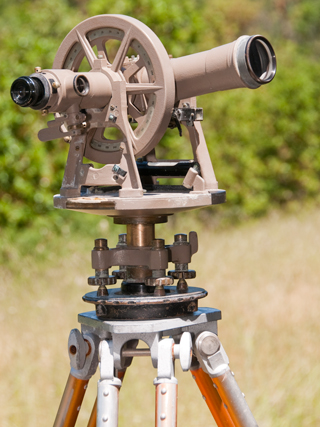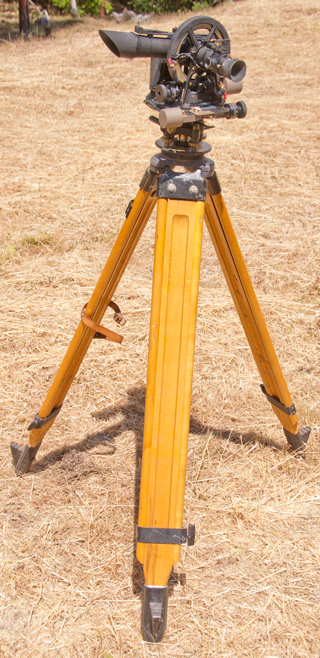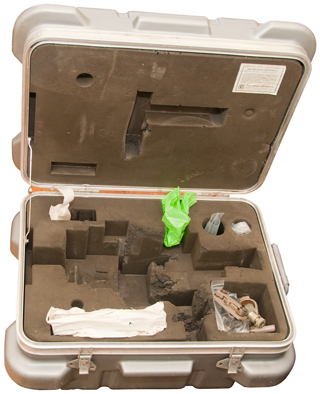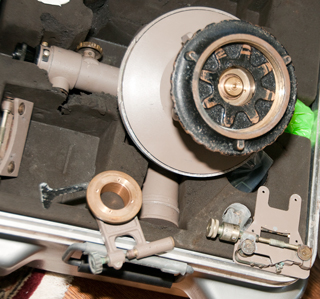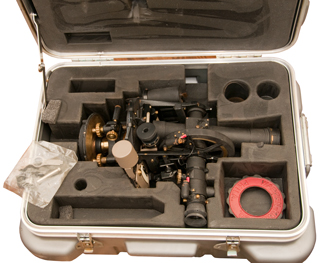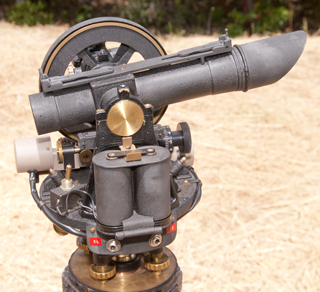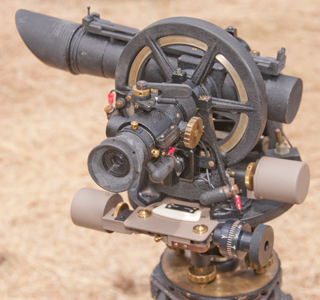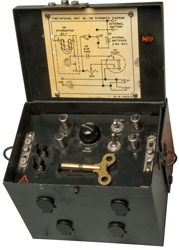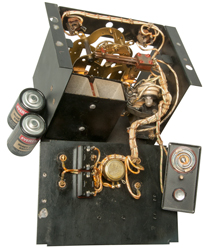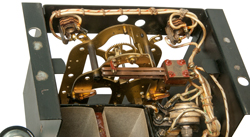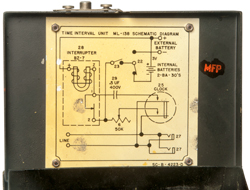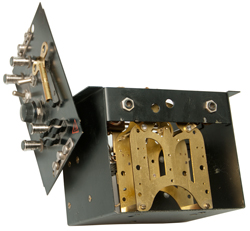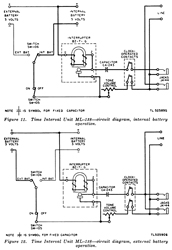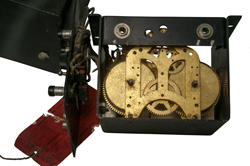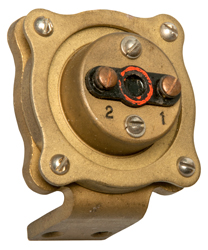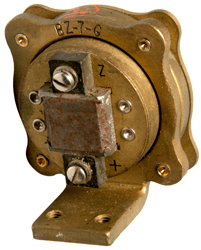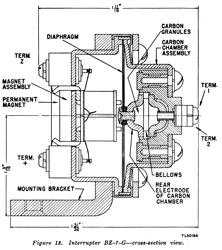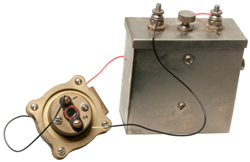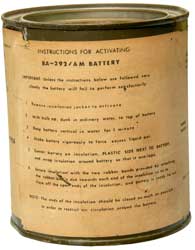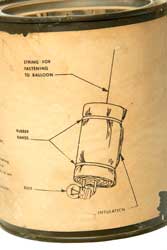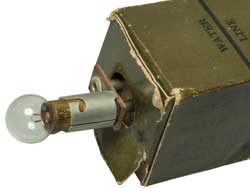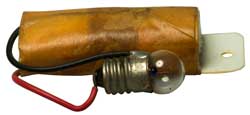Warren-Knight Theodolites
© Brooke Clarke 2016 - 2022
20-8403 Pibal
|
20-8353 Telemetering
|
Balloons
Table
Theory
Description
Operation
Photos
Patents
ML-138 Time Interval Unit
s/n: 246
s/n: 704
Patents
PIBAL Lights
AA BC M1 Observation Instrument
Related
References
Links
Background
It turns out Radiosondes has a very strong relationship with Sonobuoys and Pilot Balloons (PIBAL).
Sonobuoys use water activated batteries as are most radiosonde batteries and they both use VHF or UHF radio transmissions to send data/audio. They both have an operational life measured in minutes or hours, not days or any time longer. Both are made to be light weight. They are both considered single use, i.e. expendable.
Pilot Balloons (PIBAL) are part of learning about the upper air as are radiosondes. They overlap in that PIBALs do not carry a radiosonde, but are used by themselves or with a PIBAL light for low light conditions.
This instrument was made by Warren-Knight and they are still in business (web page). Most of the PIBAL theodolites have electronic readouts, but they still make this 8403 model as well as another all mechanical model 8500.
This theodolite is designed to track a ceiling (pilot) balloon, it's also called a PiBal (Pilot Balloon) theodolite. Since the balloon is usually at a high viewing angle the optical design has a right angle bend so that the observer always looks horizontally into the eyepiece and the elevation of the balloon does not effect the observer. This might be called a Nasmyth telescope (Wiki). This is very different from a normal theodolite that you can not use at high elevation angles without a 90 degree eyepiece adapter. It also makes this telescope suitable for astronomical measurements.
This W-K 20-8403 is a commercial version of the military ML-474 PIBAL theodolite. They work with the MT-1309 tripod or MT-180 fixed mount.
My interest is for looking at stars, and Polaris (Wiki) in particular but also for it's use in relation to weather.
Balloons
There are a number of balloon types See Ref: TM 11-2405 Meteorological Balloons.
Ceiling - used to determine the height of the bottom of clouds
Pilot - used to determine the winds aloft.
Sounding - to lift a Radiosonde
Ballast - used to control the rate of assent of a sounding balloon.
Any of the above may carry a light or radar reflector.
Table
From TM 11-6660-218-12
Model
Type
Wt
(grams)
Color
Rise
Feet/min
Burst
Feet
Vol
Cu ft
Free Lift
grams
ML-50-A
Pilot
30
White
600
30,000
6
132
ML-51-A
"
"
Black
"
"
"
"
ML-64-A
"
"
Red
"
"
"
"
ML-159-A
"
100
White
900
45,000
24
575
ML-160-A
"
"
Black
"
"
"
"
ML-161-A
"
"
Red
"
"
"
"
ML-537/UM
Sounding
1000
Clear
1000
100,000
126
1600
ML-635
"
150
Clear
1312
35,000
85
1100
Theory
There are a number of different things that can be determined using a balloon. The balloons are very standardized in terms of construction and inflation so that their rate of rise will be known. Balloons are also used to raise antennas like for the Gibson Girl lifeboat survival transmitter.
Cloud Height
This is done using a ceiling balloon (Wiki) and a stop watch. Not sure if just by eye or if binoculars or a telescope is used in addition. Ceiling height is not when the balloon disapears, but rather when it starts to fade.
Ceiling height in feet = 460 * (minutes since launch)
Winds Aloft
The balloon is tracked and data recorded for time since launch, azimuth relative to true North and elevation angle. For daytime observations it's just the balloon that goes up, nothing is attached to it. In times past a water activated reserve battery was used to light a flashlight bulb so the balloon could be tracked at night.
Weather
To determine weather parameters aloft a Radiosonde (Wiki) can be lifted by the balloon. It transmits back the pressure, temperature and humidity. The units used in the 1950s used the pressure change to switch between temperature and humidity so that only a single parameter was transmitted and by paying attention to the time and number of cycles the pressure could be determined and the pressure is related to the altitude. Not sure if these were tracked with a pibal theodolite. But later they were tracked by the SCR-568 radar (these used to be advertized in military surplus flyers).
Disk Microphones
These are microphones supported by springs which in turn are attached to a ring. That way a mechanical shock to the stand would not make as much of a noise. A short hand name for these microphones was "disk". So when the AF put out a press release sayhing that "flying disks" were what crashed in Roswell New Mexico in 1947 a newspaper reported who was not familiar with that terminology reported that a flying "saucer" had crashed. See: Roswell Connection
Description
Mounts on a standard 3-1/2"-8 surveying tripod.
There are three ways to aim at a target:
There is a lever under the eyepiece that switches the optical path between the finder scope and the main telescope.
- Use gun type open sights (this part is in the transit case)
- Look through the low power inverting finder scope
- look through the high power inverting main telescope
There is a through compass, i.e. a compass without a scale that's only used to indicate North or South. You can see it in Fig 1 on the right just under the main telescope tube.
The 20-8403 is a first generation analog type where the readout is a veneer. Battery holder is a separate item resembling a flashlight.
The 20-8353 (W-K web page) has shaft encoders added for azimuth and elevation. Battery holder is on instrument frame and uses side-by-side "D" cells. It's intended to be located near a radio aid to navigation (ILS, MLS, VOR, TACAN, VORTAC) and the encoders are used to modulate a UHF radio transmitter. A matching telemetry receiver is in the test aircraft so that they can easily compare the instrument reading with their actual position from the theodolite.
Operation
Setup and leveling is the same as for any surveying tripod mounted transit or theodolite. And like a surveying instrument the elevation angle is relative to a bubble level. But unlike a surveying setup the azimuth scale needs to be referenced to true north. TM 11-6675-200-10 for the military ML-47 lists a number of ways of finding North in order to calibrate the azimuth scale. The ways of orienting the azimuth scale to North are: Compass, Sun, Polaris, Equal star/Sun Angles, Datum Lines or Transference.
Photos
8403
Fig 1 Pibal theodolite mounted on 3-1/2-8 surveying tripod
Fig 2 Transit case with factory label.
Fig 3 bottom & Az cal assy
Installing Az cal assy requires special 2-pin spanner.
8353
Patents
Class
33: Geometrical Instruments
73: MEASURING AND TESTING
235: REGISTERS
340: COMMUNICATIONS: ELECTRICAL
342: COMMUNICATIONS: DIRECTIVE RADIO WAVE SYSTEMS AND DEVICES (E.G., RADAR, RADIO NAVIGATION)
356: OPTICS: MEASURING AND TESTING
702: DATA PROCESSING: MEASURING, CALIBRATING, OR TESTING
708: ELECTRICAL COMPUTERS: ARITHMETIC PROCESSING AND CALCULATING
940329 Optical instrument for determining the direction of travel of air-ships and the like, Otto Krell, Nov 16, 1909, 356/150; 33/318; 74/5.3 - gyroscopic stabilized right angle telescope for looking at the ground from the balloon.
1296477 Instrument for Recording the paths of Aeroplanes, G.J.N. Carpentier, Mar 4, 1919, 33/228 434/15-
1425682 Sextant for use with balloons, Robert S Olmsted, 1922-08-15 -
1446574 Nephoscope (Wiki), Alexander McAdie, Feb 27, 1923, 33/284, 356/27, 33/1.00R - measuring the altitude, direction, and velocity of clouds
1743979 Sextant, L. Radford et al, American Sextant Corp (K&E?) Jan 14, 1930 -
1913512 Meteorological indicator, Anita Reynolds, Jun 13, 1933, 73/170.11, 73/170.15, 73/170.8, 73/178.00R, 333/24.00C, 340/949, 340/870.1, 73/170.16, 341/173, 73/170.28 - radiosonde
1967541 Balloon theodolite, Schoute Cornelius. Carl Zeiss, 1934-07-24, - track balloon and read scales, and plot on map
2027367 System of determining meteorological conditions by radio, William R Blair, Jan 14, 1936, 342/450, 340/870.28, 73/170.28, 340/870.1, 455/61, 342/460 -balloon & radiosonde
2162582 Device and Method for Determining Upper Air Wind Direction and Velocity, H.B. Kaster, June 13, 1939 33/228, 33/274 - instrument for observing a free balloon and method of determining wind speed & direction
2216161 Apparatus for making meteorological observations, Allen V Astin, Leon F Curtiss, Oct 1, 1940, 340/870.28, 73/170.28, 346/33.0TP, 235/61.00B, 346/50, 346/33.00B - balloon & radiosonde
2347160 Radiometeorograph transmitting apparatus, Charles F Wallace (Wallace & Tiernan), Apr 18, 1944, 340/870.1, 340/870.28, 73/170.28, 340/870.13, 200/56.00R, 340/870.12, 200/19.21 - barometer switches temp and humidity
2381009 Chronometric radiosconde system, Joseph A Siderman, Aug 7, 1945, 340/870.1, 307/651, 455/91, 340/870.12, 340/870.16, 340/870.13, 307/650, 455/98 - radiosonde: uses clockwork to switch sensors & reference resistor for calibration
2519180 Wind data computer, William K Ergen, Aug 15, 1950, 702/3, 235/413, 708/809, 235/400 - convert free balloon observations more useful data
2651459 Velocity and direction computer, James M Brady, Athelstan F Sipilhaus, Sep 8, 1953, 235/413, 33/1.00R, 701/519 - convert free balloon observations more useful data
Nephoscope (Wiki)
" is a 19th-century instrument for measuring the altitude, direction, and velocity of clouds"
Free Google book: Instructions for erecting and using Weather Bureau nephoscope, 1919 pattern, 10 pages
1446574 Nephoscope, Mcadie Alexander, 1923-02-27, 33/284; 33/1R; 356/27 - gimbal stabilized by a weight
2420227 Nephoscope, Coburn William Knowlton, Serdex Inc, 1947-05-06, 33/227; 73/170.11; 73/170.16 - looks like a pistol, has interval timer, compass, and high elevation angle sight.
ML-138 Time Interval Unit
This generates a 1 kHz tone lasting 7 seconds once each minute. Observations are made when the tone stops. The ML-138 can also be used with the EE-8 field phone. (I expect it would also work with other field phones.)
Ref: TM 11-334 Timing and Telephone Set ML-110, War Department, June 1946 (pdf). - "Timing and Telephone Set ML-110 consists of Time Interval Unit ML-138 and associated equipment. The timing and telephone set is designed as an aid in making theodolite observations of pilot balloons. It provides two services : telephonic communication between a plotting station and one or two theodolite observers, and superimposed timing signals on the telephone communication line to aid the observer in making periodic observations of balloon positions."
"Time Interval Unit ML-138 continuously generates a tone of about 1,000 cycles per second. This tone is transmitted intermittently to the line by a timer which is based on a modified 8-day clock. A special interrupter (BZ-7), operating from two Batteries BA-30, serves as the tone generator."
Also see: TM 11-1158A and TM 1-235.
"The timing and telephone set uses sound-powered telephone equipment requiring no battery power. The operating range of the equipment is limited to about 3 miles of Wire W-130-A or its equivalent." Head and Chest Set HS-25, HS-25A, or B (Radio Nerds) Includes a single earphone w/dual wire head support. The H-200/U includes headphones with two earphones.
The BZ-7 is also used on the TG-5 Telegraph Set. The GR 650 Impedance Bridge uses a similar "Hummer".
Patents
2396497 Timing control circuit, Eisenberg Ben, Lektra Labs, App: 1941-09-27, W.W. II, Pub: 1946-03-12, - dosing for electroshock
1516260 Inclosed-diaphragm buzzer, F.W. Wood, 1919-08-07 - half of a BZ-7, i.e. missing the carbon mike.
s/n: 246
my first ML-138 appears new but incomplete. Missing screwdriver (left side of front panel) and the clock internal parts.
Fig 1
Fig 2 Do not see a main spring!
What makes the clock tick?
Let me know.
Dead "D" batteries look old.
Fig 3
Fig 4
Fig 5 MISSING main spring and gearing!!
Wiring diagram from TM 334 page 44
s/n: 704
Second ML-138 appears well used and non functional.
The hope is that the clockwork from s/n 704 can be transplanted into s/n 246 making a functional unit.
2022 Mar 19 - after removing clockwork and applying a tiny drop of oil to key locations it's been running for a few hours.
Fig 1
Fig 2
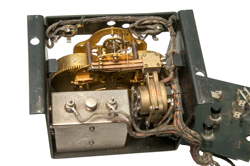
Fig 3 Maybe Seth Thomas No, 10 2-42
These movements show up on eBay (Seth Thomas #10)
YouTube:Antique Seth Thomas Overhaul - Slick 50 for mainspring
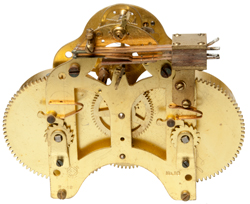
Fig 4
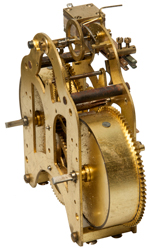
Fig 5
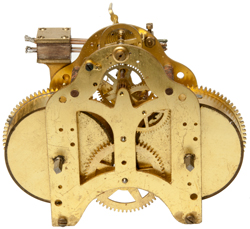
Fig 6 BZ-7-G 1 kHz buzzer (3 VDC)
Resistance 1 to 2 varies a lot, about 200 Ohms.
MIL-B-13106 (discontinued 1972)
Fig 7 BZ-7-G 1 kHz buzzer (3 VDC)
Resistance + to Z = 52 Ohms.
BZ-7 diagram from TM 334 page 45
Fig 8 BZ-7_G & 3VDC supply
With a couple of "D" cells it runs at about 1400 Hz.
PIBAL Lights
No matter what type of balloon (Ceiling, Sounding or Pilot) every gram of payload weight is accounted for. So the weight of the battery + light will determine the size of the balloon that can carry it.
MIL-B-10154C Batteries, Primary Water-activated (Dunk Type)
Battery
Vnom
Volts
Flight Wt.
g
Normal Discharge
Time min
BA-253/U 6
80 +/- 10
32
BA-259/AM 1.5, 6 & 115
<=450
90
BA-292/AM 3.2
25 +/- 5
38
BA-316/AM 7 & 120
<=450
90
BA-292/AM
Ten of these come in a one quart paint can.
I expect the battery gets warm as it works. Insulating it may keep the water from freezing which would stop the battery from making any electricity.
The battery and insulation jacket weighs 22.68 grams so with a couple of rubber bands might weigh 23 grams.
Westinghouse 366 lamp.
BA-253/U
The BA-253/U water activated battery has a socket with two different diameters. I'm guessing that it's a socket commonly used on batteries to insure the correct polarity. Reusing a socket like this is much more economical than having a custom non polarized socket made as a custom product. The battery also has a lifting loop, meaning this battery was made specifically for use on a balloon to power a flashlight bulb. The bulb is marked CM 604. Spherical glass bulb 14mm dia (G-4-1/2) .
Dry weight 65 g (2.3 oz).
PIBAL Light
Probably a BA-292 or equivalent
11mm dia bulb, E10 screw base
Marked: 2.5 Volts
A.A. B.C, M1 Observation Instrument
This appears to be an AntiAircraft Battery Commander's Observation Instrument. I uses an optical system very similar to a PIBAL theodolite.
TM 9-1665, March 2, 1943
Horizontal Angle: 0 to 6400 mills within 0.1 mil
Vertical Angle: 0 to 1500 mills within 1 mil.
Might use Elbow Telescope M2, M2A1 (spotting), M3 or M35 (main scope). These show up on eBay is just the elbow telescope.
Related
Astronomy
Surveying
Theodolites
Lietz 115 transit
Weather
Pendulum Astrolabe
Radiosounde
References
Martin Brenner's, Pilot Balloon Resources -
Military Manuals
Radio Nerds Weather
TM 11-2400 Generators ML-185-A and ML-185-B (Hydrogen) War Department, May 1945 (Radio Nerds pdf)
TM 11-2405 Meteorological Balloons, War Department, 24 April 1944 - Ceiling Balloons, Pilot Balloons, Sounding Balloons, Ballast Balloons (Radio Nerds pdf)
TM 11-2424 Modulated Audio Observations, Feb 1945 (Radio Nerds pdf)
Batteries
BA-67: 3V & 90V, 700 grams
4X2V60: 3V & 90V; 350 gramms
4X2W60: 3V & 90V; 700 gramms
X-542: 3V & 90V; 450 gramms
TM 11 6660-258-25P ML-474 (Pilot Balloon type) PIBAL
TM 11-6675-200-10 ML-247 (Pilot Balloon type) PIBAL
TM 5-6675-200-14
TM 5-6675-200-25P
TM 11-6675-200-25P ML-247 (Pilot Balloon type) PIBAL
TM-11-6675-200-35 (Pilot Balloon type)
Theodolites ML-47 - C through ML-47-R,
ML-247 and ML-247-A and
Books
Invention of the Meteorological Instruments by W.E. Knowles Middleton, 1969, Lib of Congress Card Catalog: 68-31640, 362 pages.
Other Ref
Wiki: Ceiling Balloon
Links
YouTube:Launching a weather balloon with the US National Weather Service, 5:01 -
Martin Brenner's, Pilot Balloon Resources -
Liberated Manuals - theodolite -
PRC68, Alphanumeric Index of Web pages, Contact, Products for Sale
Back to Brooke's: PRC68, alphanumeric index of web pages, Products for Sale
